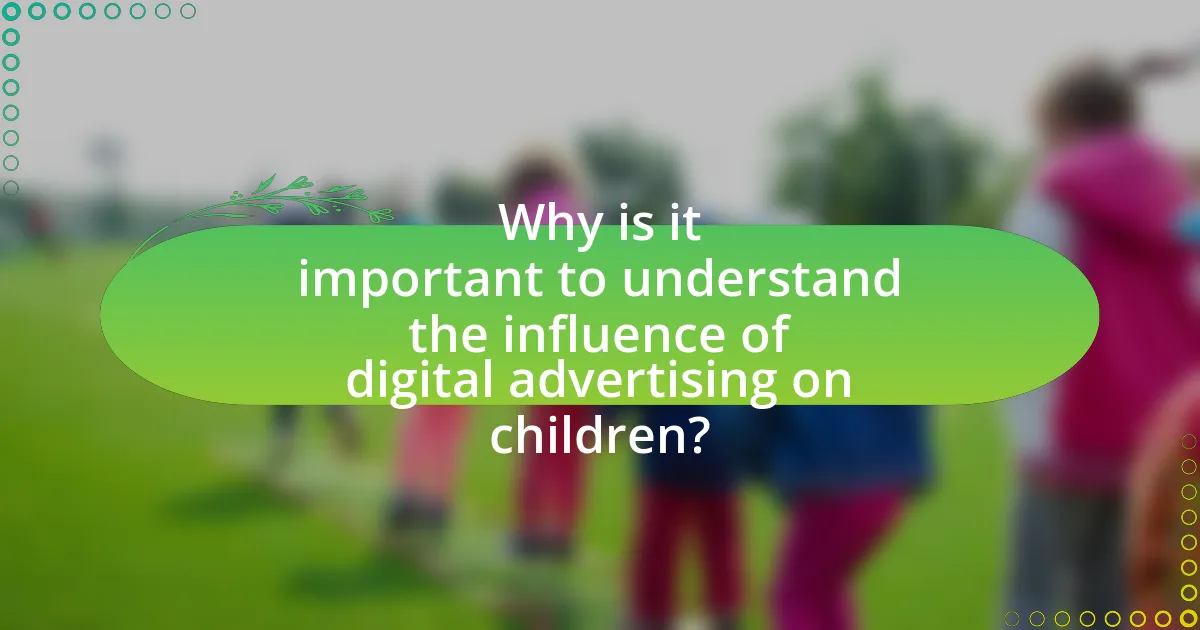Digital advertising has a profound influence on children’s behavior, shaping their preferences, consumption patterns, and social interactions. Research indicates that children exposed to digital ads are more likely to develop brand loyalty and make unhealthy dietary choices, as they often lack the critical thinking skills to discern advertising intent. The article explores how digital advertising specifically targets children through tailored content and persuasive techniques, the cognitive factors affecting their responses, and the potential long-term implications on their values and social dynamics. Additionally, it discusses the role of parental guidance, educational initiatives, and regulatory frameworks in mitigating the negative effects of advertising on children.
What is the influence of digital advertising on children’s behavior?
Digital advertising significantly influences children’s behavior by shaping their preferences, consumption patterns, and social interactions. Research indicates that children exposed to digital advertisements are more likely to develop brand loyalty and request advertised products, as evidenced by a study published in the Journal of Advertising Research, which found that children aged 6 to 12 who viewed food advertisements were more likely to choose those products over healthier options. Furthermore, digital advertising often employs persuasive techniques, such as colorful visuals and interactive content, which can lead to increased impulsivity in purchasing decisions among children. This influence is compounded by the fact that children often lack the critical thinking skills necessary to discern advertising intent, making them more susceptible to marketing messages.
How does digital advertising target children specifically?
Digital advertising targets children specifically through tailored content, interactive formats, and data-driven strategies. Advertisers utilize platforms popular among children, such as social media and gaming apps, to deliver engaging advertisements that resonate with young audiences. For instance, studies show that children are more likely to respond to ads featuring animated characters or interactive elements, which enhance engagement and retention. Additionally, data analytics allow advertisers to track children’s online behavior, enabling them to customize ads based on interests and preferences, thereby increasing the effectiveness of their campaigns.
What techniques are used in digital advertising to appeal to children?
Digital advertising employs various techniques to appeal to children, including colorful visuals, interactive content, and the use of popular characters. Colorful visuals attract children’s attention and stimulate their interest, while interactive content, such as games and quizzes, engages them actively, making the advertising experience more enjoyable. Additionally, the incorporation of popular characters from movies or television shows creates a sense of familiarity and trust, encouraging children to connect with the product being advertised. Research indicates that advertisements featuring beloved characters can significantly increase children’s desire for the product, as they often associate these characters with positive emotions and experiences.
How do children’s cognitive abilities affect their response to digital ads?
Children’s cognitive abilities significantly influence their response to digital ads by affecting their comprehension, attention, and critical thinking skills. Younger children, typically under the age of 8, often struggle to differentiate between entertainment and advertising, leading them to accept ads at face value without skepticism. Research indicates that children in this age group are more likely to be influenced by the emotional appeal of ads rather than their informational content, as they have not yet developed the cognitive skills necessary for critical evaluation (Nairn & Fine, 2008). As children grow older, their cognitive abilities improve, allowing them to better understand persuasive intent and recognize advertising tactics, which can lead to more discerning responses to digital ads. This developmental trajectory highlights the importance of age and cognitive maturity in shaping children’s interactions with digital marketing.
What are the potential effects of digital advertising on children’s behavior?
Digital advertising can significantly influence children’s behavior by shaping their preferences, increasing materialism, and promoting unhealthy habits. Research indicates that children exposed to digital advertisements are more likely to develop a preference for advertised products, which can lead to increased requests for those items from parents. A study published in the journal “Pediatrics” found that children who viewed food advertisements were more likely to choose unhealthy snacks over healthier options, demonstrating a direct link between advertising exposure and dietary choices. Additionally, digital advertising often targets children with persuasive techniques that can foster materialistic values, leading to a desire for constant consumption and dissatisfaction with what they have.
How does exposure to digital advertising influence children’s purchasing decisions?
Exposure to digital advertising significantly influences children’s purchasing decisions by shaping their preferences and increasing their desire for advertised products. Research indicates that children are particularly susceptible to persuasive advertising techniques, which can lead to a higher likelihood of requesting or purchasing items they have seen in ads. For instance, a study published in the journal “Pediatrics” found that children exposed to food advertisements were more likely to choose those products over healthier options, demonstrating a direct correlation between ad exposure and product preference. Additionally, the interactive nature of digital platforms enhances engagement, making children more receptive to marketing messages. This combination of persuasive content and interactive engagement underscores the powerful impact of digital advertising on children’s consumer behavior.
What impact does digital advertising have on children’s social interactions?
Digital advertising significantly impacts children’s social interactions by shaping their perceptions of social norms and influencing their peer relationships. Research indicates that exposure to digital advertisements often promotes materialism and unrealistic standards, which can lead to social comparison among children. A study published in the Journal of Consumer Research found that children exposed to advertisements are more likely to engage in competitive behaviors with peers, as they strive to attain the products and lifestyles depicted in ads. This competitive dynamic can strain friendships and alter social dynamics, as children may prioritize brand affiliation over genuine connections.

Why is it important to understand the influence of digital advertising on children?
Understanding the influence of digital advertising on children is crucial because it shapes their perceptions, behaviors, and purchasing decisions. Research indicates that children are particularly susceptible to advertising messages, often failing to critically evaluate the content, which can lead to unhealthy consumption habits and materialistic values. For instance, a study published in the journal “Pediatrics” found that exposure to food advertising significantly increases children’s preferences for unhealthy food options, impacting their dietary choices and overall health. This highlights the need for awareness and regulation to protect children from potentially harmful advertising practices.
What are the long-term implications of digital advertising on children’s development?
Digital advertising has significant long-term implications on children’s development, primarily influencing their cognitive, emotional, and social growth. Research indicates that exposure to digital advertisements can lead to increased materialism, as children may develop a preference for branded products over unbranded ones, impacting their value systems and self-esteem. A study published in the Journal of Consumer Research found that children exposed to advertising are more likely to exhibit a desire for material possessions, which can affect their interpersonal relationships and overall well-being. Additionally, digital advertising often promotes unhealthy food choices, contributing to long-term health issues such as obesity, as evidenced by findings from the American Journal of Public Health, which highlight the correlation between advertising exposure and poor dietary habits in children. These implications underscore the need for careful consideration of digital advertising’s role in shaping children’s developmental trajectories.
How can digital advertising shape children’s values and preferences?
Digital advertising can shape children’s values and preferences by exposing them to targeted messages that influence their perceptions and choices. Research indicates that children are particularly susceptible to advertising due to their developmental stage, which affects their ability to critically evaluate marketing messages. For instance, a study published in the Journal of Advertising Research found that children aged 8 to 12 are more likely to develop brand loyalty based on exposure to digital ads, as these ads often utilize engaging visuals and interactive elements that resonate with their interests. Furthermore, digital advertising frequently promotes materialism and consumerism, which can lead children to prioritize possessions and brand affiliation over other values. This influence is compounded by the pervasive nature of digital media, where children encounter advertisements across various platforms, reinforcing specific preferences and behaviors.
What role does parental guidance play in mitigating negative effects?
Parental guidance plays a crucial role in mitigating the negative effects of digital advertising on children’s behavior by providing oversight and education about media consumption. Research indicates that when parents actively engage in discussions about advertisements, children develop critical thinking skills that enable them to discern marketing tactics and resist impulsive buying behaviors. For instance, a study published in the Journal of Consumer Research found that children who received parental guidance were less likely to exhibit materialistic attitudes and were better at recognizing persuasive intent in advertisements. This active involvement helps children navigate the complexities of digital media, reducing the likelihood of adverse outcomes such as unhealthy eating habits or unrealistic body image perceptions influenced by advertising.
How does the regulatory environment affect digital advertising aimed at children?
The regulatory environment significantly restricts digital advertising aimed at children by imposing guidelines that protect young audiences from misleading or harmful content. For instance, regulations such as the Children’s Online Privacy Protection Act (COPPA) in the United States require parental consent for the collection of personal information from children under 13, thereby limiting data-driven advertising practices. Additionally, the Federal Trade Commission (FTC) enforces rules that prohibit deceptive advertising targeted at children, ensuring that advertisements are truthful and not exploitative. These regulations shape how companies design their marketing strategies, compelling them to create age-appropriate content that adheres to legal standards, ultimately influencing the nature and effectiveness of digital advertising directed at children.
What laws and guidelines exist to protect children from harmful advertising?
Laws and guidelines that protect children from harmful advertising include the Children’s Online Privacy Protection Act (COPPA) in the United States, which restricts the collection of personal information from children under 13 without parental consent. Additionally, the Federal Trade Commission (FTC) enforces regulations against deceptive advertising practices targeting children, ensuring that advertisements are not misleading. In the European Union, the Audiovisual Media Services Directive (AVMSD) sets strict rules on advertising to children, including limitations on the types of products that can be marketed and the timing of such advertisements. These laws and guidelines aim to safeguard children from exploitation and ensure that advertising is appropriate for their age and understanding.
How effective are these regulations in practice?
The effectiveness of regulations on digital advertising aimed at children is limited in practice. Studies indicate that despite existing regulations, children are still exposed to high levels of digital advertising, which influences their behavior and purchasing decisions. For instance, a report by the American Psychological Association found that children aged 8 to 12 are exposed to an average of 25 advertisements per day on digital platforms, undermining the intended protective measures. Furthermore, compliance with regulations varies significantly among advertisers, leading to inconsistent enforcement and effectiveness.

What strategies can be employed to minimize the negative influence of digital advertising on children?
To minimize the negative influence of digital advertising on children, implementing stricter regulations on advertising content aimed at minors is essential. Research indicates that children are particularly susceptible to persuasive advertising techniques, which can lead to unhealthy consumption habits and materialism. For instance, the American Psychological Association has highlighted that children under the age of eight often cannot distinguish between entertainment and advertising, making them vulnerable to manipulation.
Additionally, promoting media literacy programs in schools can empower children to critically analyze advertisements, helping them understand the intent behind marketing strategies. Studies show that children who receive media literacy education are better equipped to recognize advertising tactics and make informed choices.
Furthermore, encouraging parental involvement in children’s media consumption can also mitigate negative effects. Parents can guide discussions about advertising messages and help children develop critical thinking skills regarding what they see online.
These strategies collectively aim to create a safer digital environment for children, reducing the potential harm caused by digital advertising.
How can parents effectively manage their children’s exposure to digital ads?
Parents can effectively manage their children’s exposure to digital ads by implementing strict screen time limits and utilizing ad-blocking software. Research indicates that children are particularly susceptible to advertising, with studies showing that exposure can influence their preferences and purchasing behaviors. By setting specific time frames for device usage, parents can reduce the amount of time children spend viewing ads. Additionally, using ad-blockers can prevent children from encountering targeted advertisements, thereby minimizing their exposure to potentially manipulative marketing tactics.
What tools and resources are available for parents to monitor digital advertising?
Parents can utilize various tools and resources to monitor digital advertising, including parental control software, browser extensions, and educational resources. Parental control software like Qustodio and Norton Family allows parents to track and limit their children’s exposure to online ads. Browser extensions such as AdBlock Plus and uBlock Origin can block unwanted advertisements, providing a cleaner browsing experience. Additionally, resources like Common Sense Media offer reviews and guidance on the impact of digital advertising on children, helping parents make informed decisions about their children’s media consumption. These tools collectively empower parents to manage and mitigate the influence of digital advertising on their children’s behavior.
How can parents educate children about advertising tactics?
Parents can educate children about advertising tactics by discussing the purpose and techniques of advertisements, such as emotional appeals and persuasive language. Engaging children in conversations about the advertisements they encounter helps them recognize strategies used to influence their decisions. Research indicates that children as young as 8 can understand the persuasive intent of advertising when guided appropriately. By analyzing specific ads together, parents can highlight elements like celebrity endorsements or exaggerated claims, fostering critical thinking skills. This approach not only increases awareness but also empowers children to make informed choices regarding their consumption.
What role do educators play in addressing digital advertising’s impact on children?
Educators play a crucial role in addressing digital advertising’s impact on children by fostering critical thinking and media literacy skills. They can implement curricula that educate students about the persuasive techniques used in digital advertising, helping children recognize and analyze advertisements critically. Research indicates that media literacy education can significantly reduce the susceptibility of children to advertising messages, as shown in a study published in the Journal of Advertising Research, which found that students exposed to media literacy programs demonstrated a 30% decrease in the likelihood of being influenced by digital ads. By equipping children with these skills, educators help them navigate the digital landscape more effectively and make informed choices regarding the content they consume.
How can schools incorporate media literacy into their curriculum?
Schools can incorporate media literacy into their curriculum by integrating lessons that focus on analyzing and evaluating media messages, particularly those related to digital advertising. This can be achieved through specific modules that teach students to critically assess the intent, target audience, and persuasive techniques used in advertisements. Research indicates that media literacy education can enhance students’ ability to recognize and resist manipulative advertising strategies, thereby influencing their behavior positively. For instance, a study by the Center for Media Literacy found that students who received media literacy training demonstrated improved critical thinking skills regarding media content.
What initiatives can be taken to raise awareness among students about advertising?
To raise awareness among students about advertising, educational programs can be implemented that focus on critical media literacy. These programs should teach students how to analyze and interpret advertisements, understanding the techniques used to influence consumer behavior. Research indicates that media literacy education can significantly enhance students’ ability to critically evaluate advertising messages, as shown in a study by the Center for Media Literacy, which found that students exposed to media literacy programs demonstrated improved critical thinking skills regarding advertising content. Additionally, workshops and interactive sessions with advertising professionals can provide real-world insights, further engaging students in discussions about the ethical implications and psychological effects of advertising on their behavior.
What best practices can be adopted by advertisers to promote responsible advertising to children?
Advertisers can promote responsible advertising to children by adhering to age-appropriate content guidelines and ensuring transparency in their messaging. Age-appropriate content guidelines involve creating advertisements that are suitable for children’s developmental stages, avoiding themes that may be confusing or harmful. Transparency in messaging requires advertisers to clearly distinguish between entertainment and advertising, helping children understand when they are being marketed to. Research from the American Psychological Association indicates that children under eight years old often cannot distinguish between commercials and regular programming, highlighting the need for clear labeling and educational content. Additionally, implementing strict regulations, such as those outlined by the Children’s Advertising Review Unit, can further ensure that advertisements do not exploit children’s vulnerabilities.
How can advertisers create content that is both engaging and ethical for children?
Advertisers can create content that is both engaging and ethical for children by prioritizing age-appropriate messaging and interactive elements that promote positive values. Engaging content can include educational games, storytelling, and relatable characters that resonate with children’s experiences, while ethical considerations involve adhering to guidelines set by organizations such as the American Psychological Association, which emphasizes the importance of protecting children from manipulative advertising practices. Research indicates that children are particularly susceptible to advertising, making it crucial for advertisers to avoid exploiting their vulnerabilities and instead focus on fostering critical thinking and healthy habits through their campaigns.
What are the benefits of transparency in advertising targeted at children?
Transparency in advertising targeted at children fosters trust and promotes informed decision-making. When advertisements clearly disclose their intent and content, children can better understand the difference between entertainment and marketing, reducing the likelihood of manipulation. Research indicates that transparent advertising practices can lead to improved comprehension of advertising messages among children, as evidenced by a study published in the Journal of Advertising Research, which found that children exposed to transparent ads demonstrated a greater ability to critically evaluate marketing content. This understanding helps children develop healthier consumption habits and encourages responsible advertising practices within the industry.






